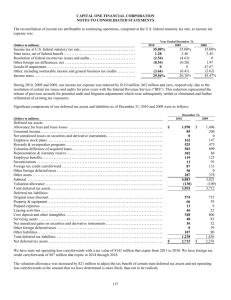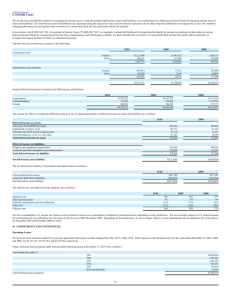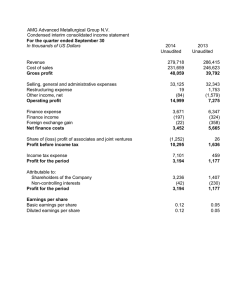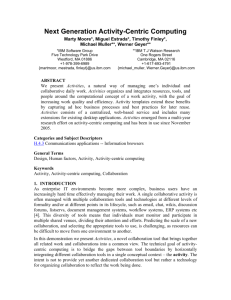IBM's Acquisition of Lotus Development Corp.
advertisement
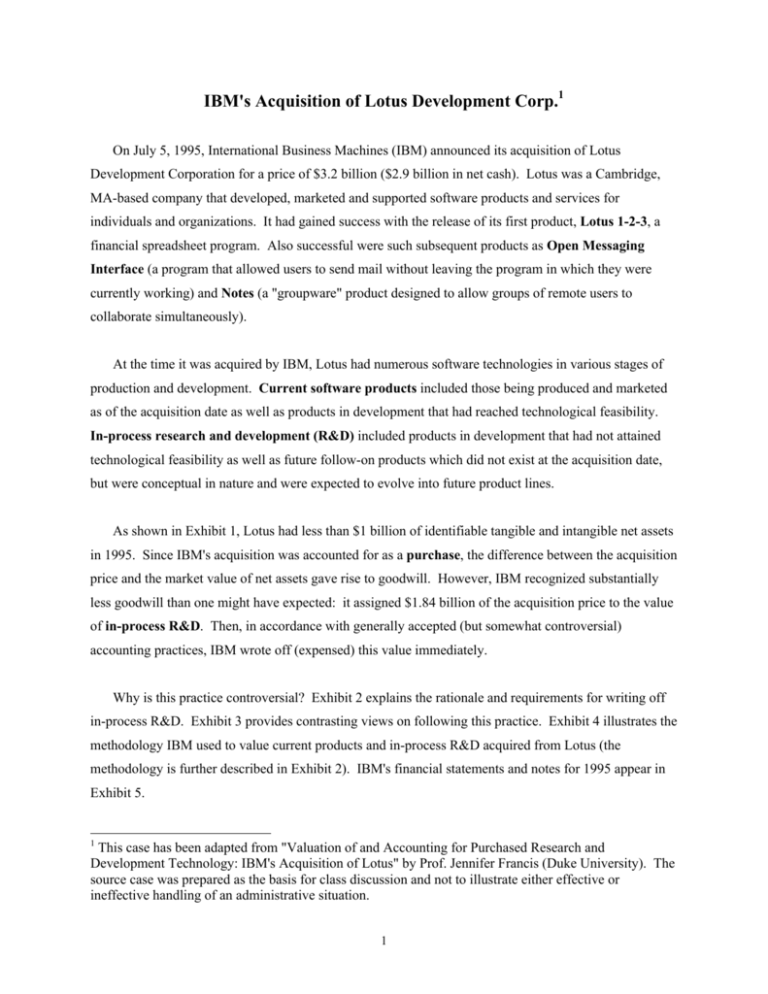
IBM's Acquisition of Lotus Development Corp.1
On July 5, 1995, International Business Machines (IBM) announced its acquisition of Lotus
Development Corporation for a price of $3.2 billion ($2.9 billion in net cash). Lotus was a Cambridge,
MA-based company that developed, marketed and supported software products and services for
individuals and organizations. It had gained success with the release of its first product, Lotus 1-2-3, a
financial spreadsheet program. Also successful were such subsequent products as Open Messaging
Interface (a program that allowed users to send mail without leaving the program in which they were
currently working) and Notes (a "groupware" product designed to allow groups of remote users to
collaborate simultaneously).
At the time it was acquired by IBM, Lotus had numerous software technologies in various stages of
production and development. Current software products included those being produced and marketed
as of the acquisition date as well as products in development that had reached technological feasibility.
In-process research and development (R&D) included products in development that had not attained
technological feasibility as well as future follow-on products which did not exist at the acquisition date,
but were conceptual in nature and were expected to evolve into future product lines.
As shown in Exhibit 1, Lotus had less than $1 billion of identifiable tangible and intangible net assets
in 1995. Since IBM's acquisition was accounted for as a purchase, the difference between the acquisition
price and the market value of net assets gave rise to goodwill. However, IBM recognized substantially
less goodwill than one might have expected: it assigned $1.84 billion of the acquisition price to the value
of in-process R&D. Then, in accordance with generally accepted (but somewhat controversial)
accounting practices, IBM wrote off (expensed) this value immediately.
Why is this practice controversial? Exhibit 2 explains the rationale and requirements for writing off
in-process R&D. Exhibit 3 provides contrasting views on following this practice. Exhibit 4 illustrates the
methodology IBM used to value current products and in-process R&D acquired from Lotus (the
methodology is further described in Exhibit 2). IBM's financial statements and notes for 1995 appear in
Exhibit 5.
1
This case has been adapted from "Valuation of and Accounting for Purchased Research and
Development Technology: IBM's Acquisition of Lotus" by Prof. Jennifer Francis (Duke University). The
source case was prepared as the basis for class discussion and not to illustrate either effective or
ineffective handling of an administrative situation.
1
Exhibit 1
(Excerpt from IBM 10-K report for 1995)
Lotus Development Corporation
On July 5, 1995, the company acquired all outstanding shares of Lotus for approximately $3.2 billion
($2.9 billion in net cash).
The company engaged a nationally recognized, independent appraisal firm to express an opinion on the
fair market value of the assets acquired to serve as a basis for allocation of the purchase price to the
various classes of assets. The appraisal included both tangible and identifiable intangible assets, as well as
software technology. The company allocated the total purchase price as follows:
(DOLLARS IN MILLIONS)
Tangible net assets
Identifiable intangible assets
Current software products
Purchased in-process research and development
Goodwill
Deferred tax liabilities related to identifiable
intangible assets
Total
$
325
542
290
1,840
540
(291)
-------$ 3,246
The tangible net assets consisted primarily of cash, accounts receivable, land, buildings, leasehold
improvements and other personal property. The identifiable intangible assets consisted of trademarks
($369 million) and other items (including employee agreements and leasehold interests) totaling $173
million. The identifiable intangible assets and goodwill will be amortized on a straight-line basis over a
five-year period.
The software technology valuation was accomplished through the application of an income approach.
Projected debt-free income (revenue net of provision for operating expenses, income taxes and returns on
requisite assets) were discounted to a present value. This approach was used for each of the Lotus product
lines. Software technology was divided into two categories: current software products and in-process
research and development.
The fair market value of the purchased current software products was determined to be $290 million. This
amount was recorded as an asset and is being amortized on a straight-line basis over two years.
Purchased in-process research and development included the value of software products still in the
development stage and not considered to have reached the technological feasibility stage.
As a result of the valuation, the fair market value of the purchased in-process research and development
was determined to be $1,840 million. In accordance with applicable accounting rules, this amount was
expensed upon acquisition in the third quarter of 1995.
2
Exhibit 2
Accounting for Research and Development
FAS No. 2, “Accounting for Research and Development Costs,” requires that all R&D costs be expensed
in the period when they are incurred. This accounting treatment focuses on the degree of uncertainty
associated with the future benefits of individual R&D projects. This uncertainty causes R&D expenses
to fail the measurability test: it is not possible to recognize as an asset a resource whose future economic
benefits are neither identifiable nor objectively measurable.
FAS No. 86, “Accounting for the Costs of Computer Software…” provides a partial exception to the rule
of expensing all R&D costs as incurred. It permits the capitalization of costs incurred subsequent to
technological feasibility, but continues to require expensing of costs that precede technological feasibility.
FASB Interpretation No. 4 (FIN-4) provides additional guidance on R&D when accounting for
acquisitions. It specifies that costs of purchasing another firm should be assigned to all identifiable
tangible and intangible assets, including any that result from R&D activities of the acquired firm or are to
be used in the R&D activities of the combined enterprise. FIN-4 further states that costs of acquired
R&D should be charged to expense unless the test of alternative future use is met.
The disclosure in Exhibit 1 reveals that IBM used the Discounted Future Benefit approach to valuing the
in-process R&D acquired from Lotus. The method involves estimating the future monetary benefits
associated with an asset, and discounting those benefits to a present value using a discount rate that
reflects the riskiness of the stream of benefits. This approach is typically used to value income producing
real estate and many intangible assets. In these situations, future benefits are often measured in terms of
net-of-tax earnings, after allowing for a pre-determined return on the assets employed.
As illustrated in Exhibit 4,2 IBM computed for each acquired Lotus product the discounted value of the
projected future stream of revenue net of operating expenses, income taxes, and returns on related assets.
The company used a forecast horizon of ten years, with a terminal calculation for the perpetuity value of
the after-tax earnings of future follow-up products. Factors used to estimate product life expectancy
included the historical experience of prior versions of the software, plans with respect to releasing future
versions of the software, and industry norms. Lotus’ historical and projected experience of issuing new
product versions indicated that the typical product had an average life of two (2) to five (5) years.
2
All data in Exhibit 4 and the product descriptions associated with them are illustrative only. They
neither reflect actual technologies acquired by IBM from Lotus, nor represent actual data used. However,
for the purposes of this case, you should treat them as “real data” that are used internally and not publicly
disclosed.
Exhibit 4 shows the valuation of WordSpeak, a technology to convert oral communications into
editable (typed) documents. This technology was in the preliminary development state when IBM
acquired Lotus, and was not expected to be marketable until the year 2000. Introduction of WordSpeak
was expected to revolutionize word processing technology.
3
Exhibit 3
Comments on Writing-Off Acquired R&D
In the Sept. 97 Mergers & Acquisitions, Bryan Browning of Valuation Research Corp. wrote:
[I]t appears that some acquirers have been going to great lengths to maximize the cost allocated to R&D
and to minimize that ascribed to goodwill. The FASB and the SEC are concerned because excessive
R&D write-offs would result in low book values for companies' assets and in overstated returns on equity.
... So, for companies planning an acquisition in the near future, beware: A large allocation to R&D will
have to be supported by an expert, well-documented valuation.
In May, 1997, Elizabeth MacDonald of the Wall Street Journal wrote:
Jack Ciesielski, editor of the Analyst's Accounting Observer, a Baltimore publication for stock analysts,
warns, "Investors should be careful of subsequent earnings posted by acquirers using this rule, because
they are a bit jazzed." Gabrielle Napolitano, a securities analyst who follows accounting issues at
Goldman Sachs, holds a similar opinion: "Acquiring companies may be assigning too high a value to this
in-process R&D, distorting subsequent earnings." …
Ciesielski says the sheer size of some of the R&D write-downs indicates that some acquiring companies
are abusing the rules by including too much goodwill. But most companies don't release the details of the
calculations they use to arrive at the write-down amounts. …
Corporate Growth Report (Weekly) in July, 1995 quoted other “experts” as saying:
"It's like manna from heaven for a company's stock." (Robert Willens, accounting analyst at Lehman
Brothers). This is the reason [FIN-4] has been a boon for high-tech acquirers this year. IBM is a prime
example. At least $ 900 million of the $ 2.6 million in goodwill BM is generating in buying Lotus will be
assigned by IBM to R&D, and thus instantly deducted from profits instead of being amortized for years.
"Investors always like to get such big charges out of the way as soon as possible," says Douglas
Robinson, a senior vice president of Computer Associates. In prior years ('93 & '94), Novell expensed a
whopping 80% of its purchase price for Unix System Laboratories and 75% of its payment for the Quattro
Pro software line.
Exhibit 4
R&D Valuation: WordSpeak
($ millions)
Product Line:
Office Software
Product:
WordSpeak, version 1.0 and beyond
Revenues
Cost of Sales
Sales & Marketing
General & Admin.
R&D
Return on Assets
Pretax Income
Taxes
Aftertax Income
1995
0
0
0
0
0
0
0
0
0
1996
0
0
0
0
0
0
0
0
0
1997
0
0
0
0
50
0
-50
-20
-30
1998
0
0
0
0
135
0
-135
-54
-81
1999
0
0
0
0
300
0
-300
-120
-180
2000
1000
315
100
115
500
100
-130
-52
-78
2001
1800
500
180
200
600
265
55
22
33
2002
2300
600
225
250
600
400
225
90
135
2003
3800
975
320
360
1000
500
645
258
387
2004
4300
1040
450
330
1350
550
580
232
348
2005+
382.8
Assume that from 2005 onward, Aftertax Income is forecasted to grow in perpetuity (i.e., forever) at 8 % per year.
Hence, using a discount rate of 16%, the PV of the forecasted Aftertax Income stream for 2005 and beyond as of
12/31/2004 is $382.8/(.16 - .08) = $4,785.0 million.
4
Exhibit 5: IBM Financial Statements for 1995
CONSOLIDATED STATEMENT OF OPERATIONS
International Business Machines Corporation and Subsidiary Companies
(DOLLARS IN MILLIONS EXCEPT PER SHARE AMOUNTS)
For the year ended December 31:
Revenue:
Hardware sales
Services
Software
Maintenance
Rentals and financing
Total revenue
Notes
1995
$
1994
1993
35,600
12,714
12,657
7,409
3,560
71,940
$ 32,344 $
9,715
11,346
7,222
3,425
64,052
30,591
9,711
10,953
7,295
4,166
62,716
21,862
10,042
4,428
3,651
1,590
41,573
30,367
21,300
7,769
4,680
3,635
1,384
38,768
25,284
20,696
8,279
4,310
3,545
1,738
38,568
24,148
16,766
6,010
22,776
15,916
4,363
20,279
18,282
5,558
8,945
32,785
947
725
1,377
1,227
1,113
1,273
Earnings (loss) before income taxes
7,813
5,155
(8,797)
Provision (benefit) for income taxes
H
Net earnings (loss) before change
in accounting principle
Effect of change in accounting principle
B
Net earnings (loss)
Preferred stock dividends and transaction costs
3,635
2,134
(810)
4,178
4,178
62
3,021
3,021
84
(7,987)
(114)
(8,101)
47
Cost:
Hardware sales
Services
Software
Maintenance
Rentals and financing
Total cost
Gross profit
Operating expenses:
Selling, general and administrative
Research, development and engineering
Restructuring charges
Total operating expenses
Operating income (loss)
7,591
I
J
5,005 (8,637)
Other income, principally interest
Interest expense
Net earnings (loss) applicable
to common shareholders
$
4,116
$ 2,937 $ (8,148)
===============================================================================
Per share of common stock amounts:
Before change in accounting principle
$
7.23
$ 5.02 $ (14.02)
Effect of change in accounting principle
B
(.20)
Net earnings (loss) applicable
to common shareholders
$7.23
$5.02 $ (14.22)
===============================================================================
Average number of common shares outstanding:
1995 - 569,384,029; 1994 - 584,958,699; 1993 - 573,239,240
The notes on pages 8 through 14 are an integral part of this statement.
5
CONSOLIDATED BALANCE SHEETS
International Business Machines Corporation and Subsidiary Companies
(DOLLARS IN MILLIONS)
At December 31:
Notes
1995
1994
Assets
Current assets:
Cash
$ 1,746
$ 1,240
Cash equivalents
5,513
6,682
Marketable securities
442
2,632
Notes and accounts receivable - trade,
16,450
14,018
net of allowances
Sales-type leases receivable
5,961
6,351
Other accounts receivable
991
1,164
Inventories
D
6,323
6,334
Prepaid expenses and other current assets
3,265
2,917
Total current assets
40,691
41,338
Plant, rental machines and other property
E
43,981
44,820
Less: Accumulated depreciation
27,402
28,156
Plant, rental machines and other property - net
16,579
16,664
Software, less accumulated amortization
(1995, $11,276; 1994, $10,793)
2,419
2,963
Investments and sundry assets
F
20,603
20,126
Total assets
$ 80,292
$ 81,091
============================================================================
Liabilities and Stockholders' Equity
Current liabilities:
Taxes
Short-term debt
Accounts payable
Compensation and benefits
Deferred income
Other accrued expenses and liabilities
Total current liabilities
Long-term debt
Other liabilities
Deferred income taxes
Total liabilities
Contingencies
H
G
G
H
$
2,634
11,569
4,511
2,914
3,469
6,551
31,648
10,060
14,354
1,807
57,869
$
1,771
9,570
3,778
2,702
3,475
7,930
29,226
12,548
14,023
1,881
57,678
Stockholders' equity:
Preferred stock, par value $.01 per share shares authorized: 150,000,000
shares issued: 1995 - 2,610,711;
1994 - 11,145,000
253
1,081
Common stock, par value $1.25 per share shares authorized: 750,000,000
shares issued: 1995 - 548,199,013;
1994 - 588,180,244
7,488
7,342
Retained earnings
11,630
12,352
Translation adjustments
3,036
2,672
Treasury stock, at cost (shares: 1995 - 424,583;
1994 - 469,500)
(41)
(34)
Net unrealized gain on marketable securities
57
Total stockholders' equity
22,423
23,413
Total liabilities and stockholders' equity
$ 80,292
$81,091
============================================================================
The notes on pages 8 through 14 are an integral part of this statement.
6
CONSOLIDATED STATEMENT OF CASH FLOWS
International Business Machines Corporation and Subsidiary Companies
(DOLLARS IN MILLIONS)
For the year ended December 31:
1995
Cash flow from operating activities:
Net earnings (loss)
Adjustments to reconcile net earnings(loss)
to cash provided from operating activities:
Effect of change in accounting principle
Effect of restructuring charges
Depreciation
Deferred income taxes
Amortization of software
Purchased in-process research and development
(Gain) loss on disposition of fixed
and other assets
Other changes that provided (used) cash:
Receivables
Inventories
Other assets
Accounts payable
Other liabilities
Net cash provided from operating activities
Cash flow from investing activities:
Payments for plant, rental machines
and other property
Proceeds from disposition of plant, rental machines
and other property
Acquisition of Lotus Development Corporation - net
Investment in software
Purchases of marketable securities and other
investments
Proceeds from marketable securities and other
investments
Proceeds from the sale of Federal Systems Company
Net cash used in investing activities
1994
1993
$4,178
$3,021
$(8,101)
(2,119)
3,955
1,392
1,647
1,840
114
(2,772) 5,230
4,197
4,710
825 (1,335)
2,098
1,951
-
(339)
(11)
151
(530)
107
(1,100)
659
1,018
10,708
653
1,518
187
305
1,772
11,793
1,185
583
1,865
359
1,615
8,327
(4,744)
(3,078) (3,154)
1,561
(2,880)
(823)
900
793
(1,361) (1,507)
(1,315)
(3,866) (2,721)
3,149
(5,052)
2,476
2,387
1,503
(3,426) (4,202)
Cash flow from financing activities:
Proceeds from new debt
6,636
5,335 11,794
Short-term borrowings less than 90 days - net
2,557
(1,948) (5,247)
Payments to settle debt
(9,460) (9,445) (8,741)
Preferred stock transactions - net
(870)
(10) 1,091
Common stock transactions - net
(4,656)
318
122
Cash dividends paid
(591)
(662)
(933)
Net cash used in financing activities
(6,384) (6,412) (1,914)
Effect of exchange rate changes on cash and
cash equivalents
65
106
(796)
Net change in cash and cash equivalents
(663)
2,061
1,415
Cash and cash equivalents at January 1
7,922
5,861
4,446
Cash and cash equivalents at December 31
$7,259
$7,922 $5,861
================================================================================
Supplemental data:
Cash paid during the year for:
Income taxes*
$1,453
$ 649 $ 813
Interest
$1,720
$2,132 $2,410
================================================================================
*Prior years restated to include withholding taxes paid on repatriation
of dividends and royalties from foreign subsidiaries.
The notes on pages 8 through 14 are an integral part of this statement.
7
NOTES TO CONSOLIDATED FINANCIAL STATEMENTS
International Business Machines Corporation and Subsidiary Companies
A
SIGNIFICANT ACCOUNTING POLICIES
Principles of Consolidation
The consolidated financial statements include the accounts of International
Business Machines Corporation and its majority-owned subsidiary companies.
Investments in business entities in which IBM does not have control, but has
the ability to exercise significant influence over operating and financial
policies (generally 20 - 50 percent ownership), are accounted for by the
equity method. Other investments are accounted for by the cost method.
Revenue
Revenue from hardware sales or sales-type leases is recognized when the
product is shipped. Revenue from one-time-charge licensed software is
recognized when the program is shipped with an appropriate deferral for postcontract customer support. This deferral is earned over the support period.
Revenue from monthly software licenses is recognized as license fees accrue;
from maintenance and services over the contractual period or as the services
are performed; from rentals and operating leases, monthly as the fees accrue;
and from financing at level rates of return over the term of the lease or
receivable. Revenue is reduced for estimated customer returns and allowances.
Selling Expenses
Selling expenses are charged against income as incurred.
Income Taxes
Income tax expense is based on reported earnings before income taxes.
Deferred income taxes reflect the impact of temporary differences between
assets and liabilities recognized for financial reporting purposes and such
amounts recognized for tax purposes. In accordance with Statement of
Financial Accounting Standards (SFAS) 109, "Accounting for Income Taxes,"
these deferred taxes are measured by applying currently enacted tax laws.
Cash Equivalents
All highly liquid investments with a maturity of three months or less at date
of purchase are carried at fair value and considered to be cash equivalents.
Inventories
Raw materials, work in process, and finished goods are stated at the lower of
average cost or market.
Depreciation
Plant, rental machines and other property are carried at cost, and
depreciated over their estimated useful lives using the straight-line method.
8
NOTES TO CONSOLIDATED FINANCIAL STATEMENTS
International Business Machines Corporation and Subsidiary Companies
Software
Costs related to the conceptual formulation and design of licensed programs
are expensed as research and development. Costs incurred subsequent to
establishment of technological feasibility to produce the finished product
are capitalized. The annual amortization of the capitalized amounts is the
greater of the amount computed based on the estimated revenue distribution
over the products' revenue-producing lives, or the straight-line method, and
is applied over periods ranging up to four years. Periodic reviews are
performed to ensure that unamortized program costs remain recoverable from
future revenues. Costs to support or service licensed programs are charged
against income as incurred, or when related revenue is recognized, whichever
occurs first.
Retirement Plans and Nonpension Postretirement Benefits
Current service costs of retirement plans and postretirement healthcare and
life insurance benefits are accrued for in the period. Prior service costs
resulting from amendments to the plans are amortized over the average
remaining service period of employees expected to receive benefits.
Goodwill
Goodwill is charged to earnings on a straight-line basis over the periods
estimated to be benefited, currently not exceeding five years.
Common Stock
Common stock refers to the $1.25 par value capital stock, as designated in
the company's Certificate of Incorporation. Earnings (loss) per common share
amounts are computed by dividing earnings (loss) after deduction of preferred
stock dividends and transaction costs by the average number of common shares
outstanding in the period.
B
ACCOUNTING CHANGES
The company implemented new accounting standards in 1995, 1994 and 1993. None
of these standards had a material effect on the financial position or results
of operations of the company.
Management uses estimates in preparing the consolidated financial statements,
in conformity with generally accepted accounting principles. Significant
estimates include collectibility of accounts receivable, warranty costs,
profitability on long-term contracts, as well as recoverability of
capitalized software costs, long-term fixed assets and residual values. The
company regularly assesses these estimates and, while actual results may
differ from these estimates, management believes that material changes will
not occur in the near term.
D
INVENTORY
At December 31:
1995
1994
$ 1,241
$ 1,442
4,990
4,636
92
256
$ 6,323
$ 6,334
(DOLLARS IN MILLIONS)
Finished goods
Work in process
Raw materials
Total
9
NOTES TO CONSOLIDATED FINANCIAL STATEMENTS
International Business Machines Corporation and Subsidiary Companies
E
PLANT, RENTAL MACHINES AND OTHER PROPERTY
At December 31:
1995
1994
$ 1,348
$ 1,437
12,653
13,093
26,658
27,084
40,659
41,614
25,604
26,299
15,055
15,315
(DOLLARS IN MILLIONS)
Land and land improvements
Buildings
Plant, laboratory and office equipment
Less: Accumulated depreciation
Rental machines and parts
Less: Accumulated depreciation
Total
F
3,322
1,798
1,524
3,206
1,857
1,349
$16,579
$16,664
INVESTMENTS AND SUNDRY ASSETS
(DOLLARS IN MILLIONS)
Net investment in sales-type leases**
Less: Current portion - net
Deferred taxes
Prepaid pension cost
Non-current customer loan receivables
Installment payment receivables
Investments in business alliances
Goodwill, less accumulated amortization
(1995, $913; 1994, $648)
Other investments and sundry assets
Total
At December 31:
1995
1994
$14,007
$14,751
5,961
6,351
8,046
8,400
3,376
4,533
2,535
1,528
2,390
2,398
844
817
509
380
870
2,033
$20,603
427
1,643
$20,126
**These leases relate principally to IBM equipment and are generally for terms ranging from three
to five years.
G
DEBT
Short-term debt
At December 31:
1995
1994
$ 4,933
$ 2,544
3,755
2,977
2,881
4,049
$11,569
$ 9,570
=======
=======
The weighted-average interest rates for commercial paper at December 31, 1995
and 1994, were approximately 5.7 percent and 4.9 percent, respectively. The
weighted-average interest rates for short-term loans at December 31, 1995 and
1994, were approximately 6.6 percent for both years.
(DOLLARS IN MILLIONS)
Commercial paper
Short-term loans
Long-term debt: Current maturities
Total
10
NOTES TO CONSOLIDATED FINANCIAL STATEMENTS
International Business Machines Corporation and Subsidiary Companies
Long-term debt
At December 31:
1995
1994
(DOLLARS IN MILLIONS)
Maturities
U.S. Dollars:
Debentures:
7%
2025
$ 600
7%
2045
150
7-1/2%
2013
550
8-3/8%
2019
750
Notes :
5-1/2% to 7-1/2%
1996-2002 3,025
7-1/2% to 9-1/2%
1996-2001
186
Medium-term note program: 5.8% average 1996-2008 1,730
Other U.S. dollars: 5.4% to 7.9%
1996-2012
416
7,407
Other currencies
Less: Net unamortized discount
550
750
3,325
641
2,803
558
8,627
12,964 16,618
23
21
12,941 16,597
2,881
4,049
$10,060 $12,548
======= =======
Less: Current maturities
Total
H
$
TAXES
(DOLLARS IN MILLIONS)
U.S. federal:
Current
Deferred
Net deferred investment tax credits
1995
U.S. state and local:
Current
Deferred
Non-U.S.:
Current
Deferred
Total provision (benefit) for income taxes
Social security, real estate, personal property
and other taxes
Total taxes
11
1994
$
1993
$
85
1,075
------1,160
49
74
------123
$
(4)
(890)
(51)
-------(945)
65
------65
68
------68
26
23
-------49
2,093
317
------2,410
-------
1,192
751
------1,943
-------
554
(468)
-------86
--------
3,635
2,134
(810)
2,566
------$ 6,201
=======
2,465
------$ 4,599
=======
2,614
-------$ 1,804
========
NOTES TO CONSOLIDATED FINANCIAL STATEMENTS
International Business Machines Corporation and Subsidiary Companies
The effect of tax law changes on deferred tax assets and liabilities did not
have a significant impact on the company's effective tax rate in 1995 and
1994 and had a beneficial impact of $170 million in 1993.
The significant components of deferred tax assets and liabilities included on
the balance sheet were as follows:
At December 31:
(DOLLARS IN MILLIONS)
1995
1994*
Deferred Tax Assets
Retiree medical benefits
Restructuring charges
Capitalized research and development
Foreign tax credits
Alternative minimum tax credits
Inventory
Doubtful accounts
General business credits
Equity alliances
Employee benefits
Intracompany sales and services
Foreign tax loss carryforwards
State and local tax loss carryforwards
Warranty
Software income deferred
Depreciation
Retirement benefits
U.S. federal tax loss carryforwards
Other
Gross deferred tax assets
Less: Valuation allowance
Total deferred tax assets
Deferred Tax Liabilities
Sales-type leases
Retirement benefits
Depreciation
Software costs deferred
Other
Gross deferred tax liabilities
$ 2,632
2,003
1,772
1,183
859
674
517
452
407
405
325
303
236
233
205
172
101
2,800
15,279
3,868
$11,411
$ 2,500
2,446
2,057
1,380
738
633
453
452
445
363
357
469
370
163
199
249
127
230
2,564
16,195
4,551
$11,644
$ 2,898
1,919
1,787
967
1,320
------$ 8,891
$ 2,862
1,061
1,653
1,283
823
------$ 7,682
The estimated reversal periods for the largest deductible temporary differences are:
Retiree Medical - 1 to 30 years; Restructuring - 1 to 7 years.
The valuation allowance applies to U.S. federal tax credits, state and local net deferred tax assets and net operating loss
carryforwards, and net operating losses in certain foreign jurisdictions that may expire before the company can utilize them. The
net change in the total valuation allowance for the year ended December 31, 1995, was a decrease of $683 million, of which
approximately $600 million was due to the realization of previously unrecognized benefits in the current year. It is reasonably
possible that the deferred tax asset valuation allowance could decrease significantly in the near term, depending on the company's
ability to generate sufficient taxable income in multiple tax jurisdictions.
12
NOTES TO CONSOLIDATED FINANCIAL STATEMENTS
International Business Machines Corporation and Subsidiary Companies
The consolidated effective income tax rate was 47 percent in 1995, 41 percent in 1994
and (9) percent in 1993.
A reconciliation of the company's effective tax rate to the statutory U.S.
federal tax rate is as follows:
For the year ended December 31:
1995
1994*
1993*
Statutory rate
U.S. valuation allowance
Foreign tax differential
State and local - net
Other
35%
(2)
2
1
2
----
35%
5
1
----
(35)%
20
7
(1)
----
38%
9
---47%
41%
---41%
(9)%
----(9)%
Effective rate before purchased in-process
research and development
Purchased in-process research and development
Effective rate
*Reclassified to conform to 1995 presentation.
For tax return purposes, the company has available tax credit carryforwards of
approximately $2,866 million, of which $67 million expire in 1996, $776 million expire
in 1998, $692 million expire in 1999 and the remainder thereafter. The company also
has state and local, and foreign tax loss carryforwards, the tax effect of which is
$539 million. Most of these carryforwards are available for ten or more years.
Undistributed earnings of non-U.S. subsidiaries included in consolidated
retained earnings amounted to $12,565 million at December 31, 1995, $11,280
million at December 31, 1994 and $10,915 million at December 31, 1993. These
earnings, which reflect full provision for non-U.S. income taxes, are
indefinitely reinvested in non-U.S. operations or will be remitted substantially free
of additional tax. Accordingly, no material provision has been made for taxes that
might be payable upon remittance of such earnings, nor is it practicable to determine
the amount of this liability.
I ADVERTISING
The company expenses advertising costs as incurred. Advertising expense amounted to
$1,219 million, $977 million and $716 million in 1995, 1994 and 1993, respectively.
J RESEARCH, DEVELOPMENT AND ENGINEERING
Research, development and engineering expenses amounted to $6,010 million in
1995, $4,363 million in 1994 and $5,558 million in 1993. Expenditures for
product-related engineering included in these amounts were $783 million, $981
million and $1,127 million in 1995, 1994 and 1993, respectively.
Expenditures of $5,227 million in 1995, $3,382 million in 1994 and $4,431
million in 1993 were made for research and development activities covering basic
scientific research and the application of scientific advances to the
development of new and improved products and their uses. Of these amounts,
software-related activities were $2,997 million, $793 million and $1,097 million in
1995, 1994 and 1993, respectively.
Included in the 1995 research, development and engineering expenses as part of software-related
activities was a $1,840 million charge for purchased in-process research and development in connection
with the acquisition of Lotus in July 1995.
13
P RENTAL EXPENSE AND LEASE COMMITMENTS
Rental expense, including amounts charged to inventories and fixed assets and
excluding amounts charged to restructuring, was $1,145 million in 1995, $1,276
million in 1994 and $1,686 million in 1993. The table below depicts gross
minimum rental commitments, under non-cancelable leases; amounts related to
vacant space, which the company had reserved for in restructuring charges and
other actions; and sublease income commitments. These amounts generally reflect
activities related to office space.
(DOLLARS IN MILLIONS)
1996
Gross rental commitments
$1,191
Vacant space
424
Sublease income commitments
105
1997
$1,035
374
94
14
1998
$ 930
333
82
1999
$ 794
259
68
2000
$ 694
236
60
Beyond
2000
$2,263
590
109
